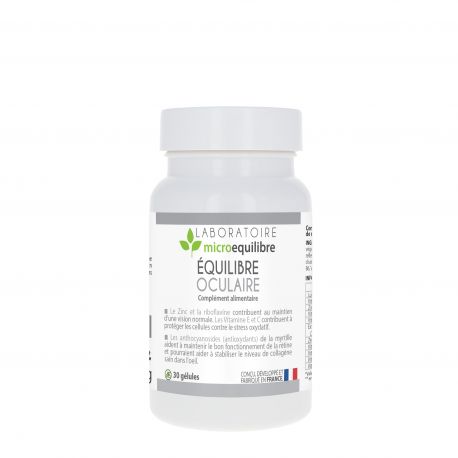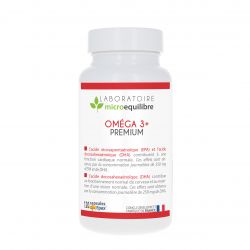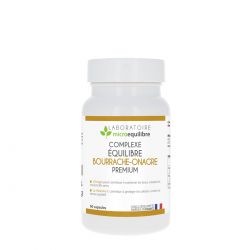

ÉQUILIBRE OCULAIRE
Dietary supplement indicated to help maintain normal vision, protect cells against oxidative stress and maintain proper retinal function, and may help stabilize healthy collagen levels in the eye.
In stock
-
Description
What is OCULAR BALANCE?
From an early age, our eyes are exposed to a wide range of aggressions: Ultraviolet rays, blue light from our smartphones, computers, tablets, televisions, energy-saving light bulbs and LED objects...
Our vision can be altered as a result.
The eye has two converging lenses: the cornea, a transparent structure that covers the iris and pupil of the eye, and the crystalline lens located behind the iris.
The cornea is the first structure encountered by light rays, which converge towards the crystalline lens and then the retina.
The retina contains a concentration of photoreceptors, rods and cones, which convert the light signal perceived by the eye into an electrical signal transmitted to the brain via the optic nerve, where it is translated into an "image".
These photoreceptors are embedded in the retinal pigment epithelium, which is supposed to nourish them.
There are two types of photoreceptors: cones and rods.
Cones are used for daytime vision, and rods for night vision.
Rods contain a pigment protein, rhodopsin, also known as "retinal purple".
Blueberries can supply the retinal that makes up this protein, which is essential for twilight and night vision.
It is also recommended for improving the resistance of ocular capillaries by promoting micro-circulation.
MICROEQUILIBRE OCULAIRE complex contains 900 mg of blueberry/ bilberry extract, concentrated in anthocyanosides, per gelcap.
Cones are concentrated in the macula, the central zone of the retina located in the extension of the pupil, which enables maximum visual acuity, with perception of details and colors in light.
The macula is also known as the "yellow spot".
Lutein and zeaxanthin belong to the carotenoid family. They are contained in the retina of the eye and are particularly concentrated in the macula.
Yellow xanthophyll pigments, they give the macula its characteristic color.
Visual acuity can be affected by a number of different mechanisms:
While certain constitutive genetic factors and age are not modifiable, certain environmental factors can contribute to impaired vision and premature cell degeneration.
Free radicals cause oxidative damage to various eye molecules.
Various ocular pathologies share the implication of oxidative stress.
In a 2019 report, ANSES confirmed the toxicity of blue light on the retina.
This toxicity is thought to result from damage to the pigment epithelium on which photoreceptors (cones and rods) depend.
Blue light could generate free radicals and promote oxidative stress in the eye.
Oxidative stress results from an imbalance between the production of oxygen radical species and the body's ability to defend itself against them.
It can be induced by increased production of free radicals, but also by a reduction in our antioxidant capacity.
Zinc helps maintain normal vision. Zinc bisglycinate ensures optimal bioavailability.
Zinc acts as a cofactor for the endogenous antioxidant enzyme Superoxide Dismutase (SOD).
Riboflavin helps maintain normal vision.
Riboflavin has an antioxidant action, acting in its FAD form as a coenzyme of glutathione reductase to convert oxidized glutathione into reduced glutathione.
Reduced glutathione is present in significant concentrations in the crystalline lens.
Numerous studies are examining riboflavin's role in protecting the lens against free radicals and preventing cataracts (opacification of the lens).
Vitamins E and C help protect cells against oxidative stress.
During the radical cascade, vitamin E provides antioxidant defense of cell membranes by donating an electron. Loss of this electron makes it an oxidized molecule, which vitamin C can regenerate.
Vitamin E and vitamin C thus act synergistically to help protect cells against the oxidative stress associated with eye degeneration.
Vitamin C is also involved in collagen synthesis.
Blueberry/ Bilberry's anthocyanosides help maintain healthy retinal function and may help stabilize healthy collagen levels in the eye.
We note that degenerative pathologies can impact the eye by inducing premature cellular aging.
The "MICROEQUILIBRE OCULAIRE" complex is made up of vitamins, minerals and anti-oxidants that work in synergy to ensure the eye's homeostasis.
Its composition takes into account the various studies recognized by the scientific community, and benefits from the latest EFSA health claims. -
Instructions of use
It is advisable to take 1 gelcap per day as a 3-month course of treatment to be renewed.
-
Precautions of use
• Food supplements should not be used as a substitute for a varied, balanced diet and a healthy lifestyle.
• Do not exceed the recommended daily dose
• Keep out of the reach of children -
Composition
Nutritional Information:
Ingredients
For 1 gelcap %NVR* Luteine 10 mg Vitamin C 80 mg 100 % Zinc 10 mg 100 % Vitamin E 12 mg 100 % Vitamin B3 16 mg Blueberry extract
of which Anthocyanins (25%)
900 mg ** Zeaxanthin 2 mg 100 % Vitamin B6 1.4 mg 100 % Vitamin B2 1.4 mg 100 % Vitamin B1 1.1 mg 100 % Vitamin B12 2.5 µg 100 % *Nutrient values of reference
**Dried plant equivalents
Ingredients:
Natural lutein, Vitamin C, Pullulan plant-based gelcaps, Zinc bisglycinate, Natural Vitamin E, Vitamin B3, Bilberry extract, Bulking agent: acacia fiber, Natural zeaxanthin, Vitamin B6, Vitamin B2, Vitamin B1, Vitamin B12.
This list of ingredients is subject to change. Please consult the packaging of the product purchased.







